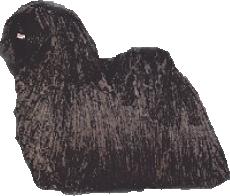 |
The mythology surrounding the grooming of the corded Puli coat is truly an awesome creation. It is not, however, to be believed in most cases. The corded coat is the natural coat for the Puli, and most good coats of Hungarian breeding show a marked tendency toward the divisions appropriate for that coat, which we need only follow and maintain with our fingers. The one essential to a good corded coat, or to a good coat of any other style for a Puli, is the total absence of fleas. As a veterinarian, I know that there are a fair number of people who think fleas are natural to the dog, and if there are only a few, it should be no big problem. WRONG. One flea in a Puli coat is a tragedy. A five year growth of cords-to-the-ground can vanish overnight. Then your five year old dog will be ten years old before the coat on his shoulders catches up with that on the rest of his body. 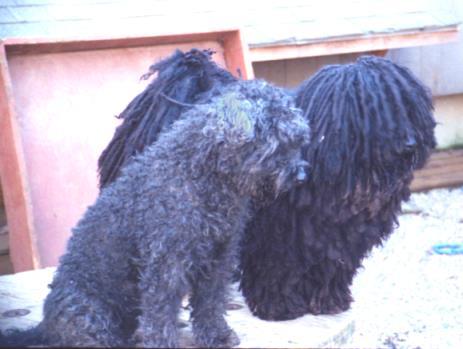 Fruzsi cut down and Smoke with a perfect "Ernyos" (umbrella) head fall Our Hungarian lines have excellent skin health, and have no tendency at all toward skin odor. If your Puli has a body odor, there is a problem and you should be exploring it to its solution before it causes the loss of the whole coat due to scratching. The coat can be encouraged to grow to the ground in cords, it can be kept in cords 5 to 6 inches long for cleanliness (it will accumulate less urine this way), or it can be scissored off to a length of 1 to 3 inches, which is what I do with my dogs after they retire from the show ring. Even this scissored coat does not need brushing, although if youíre a masochist you can try it. Contrary to some peopleís point of view, I do not believe that the Puli coat, as we know it in this kennel at any rate, ever mats. Even within one litter, there will often be quite a variety in the extent to which the self-cording separations occur. Where coats have different proportions of over and under coat, they will have a greater or lesser tendency toward proper separation all on their own. Even where no good divisions occur, however, the coat does not mat. Mats are hard tangled knots which must be cut out. Cords are a felted structure, never hard, and can easily be separated into nicely shaped cords. If the puppy coat, or one which is growing back after being scissored down, does not show good separations, and is forming a solid Ďspongeí of hair over a period of months, it is simply necessary to start at one spot and arbitrarily divide the coat into approximately one inch clumps. As long as baths and hot air drying havenít been administered while this sponge remained unseparated, it can be divided, bathed, dried, and the Puli taken into the show ring the next day. The only Puli coat which cannot be reclaimed is one where there is coat missing, whether from scratching or scissors. While the coat is there, it is always possible to put it into acceptable condition. 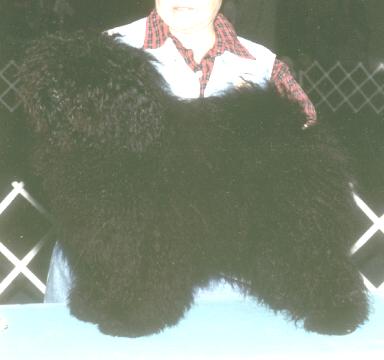 Ruffles at one year of age.
Puppy coats can pretty well be washed at will. The puppy coat never needs brushing, and if debris should accumulate, well, now is the time to get started training your fingers to pick through the puppyís coat and eliminate small seeds, grasses, twigs, or large trees, depending on your puppyís level of ambition and expertise. A note here; the Puli almost certainly evolved from a combination of sheep dog and Transylvanian beaver. It is also said that the Transylvanian beaver is responsible for the incredibly lovely woodworking in the Erdely region. The Puli, however, is not a lovely woodworker. Puli supervised woodpiles are unpiled, not piled up. No sign of artistic ability has ever been evident in the tremendous volume of woodworking my Pulik have undertaken over the years. The only time when a puppy really needs to be bathed is when he has found something sticky or evil smelling. Of course, this, too, might arise from the Transylvanian roots. Otherwise, simple dirt and mud will disappear from his coat and find its way into your bed or the pile of the carpet, so shampoo the carpet, not the puppy.
This is the Problem Time. (Is this news to anyone?) As the puppy approaches sexual maturity, the texture of the undercoat changes and becomes denser and springier. This change begins in the area of the rump, ahead of the tail, and proceeds forward, ending on the head and face. Sometimes it completes its forward progress in the course of a week, and sometimes in the course of a few months. Pray for the latter. Once your puppy reaches about 8 to 10 months old, if you wish to bathe him, you must separate his tendrils into cords, both before and after the bath. 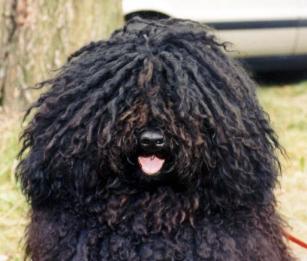 Hunor at a year and a half of age.
The puppy coat will almost always display some organization into
tendrils, with a clump of hair tending to rotate on itself. Each coat is
different, and each will do this to a different extent. As the texture
firms up on the various parts of the body, these tendrils may start to
run together near the skin. Using your fingers, make sure that these divisions
are separated down to the skin before the bath. Once again, after the puppy
is 85-90% dry, go through the coat and make sure these separations havenít
stuck back together during drying, Once it is dry, the separations will
tend to hold. The more often you wash the coat, the more unnecessary work
you will have to do and the more separating your Puli will have to endure.
Wait a good period of time in between baths, so there will be some length
to work with as your separate these clumps. The cords will form perfectly
well without daily spraying with water, frequent bathing, or anything else
except going over with your fingers to find trouble spots. If you bathe the coat too often, another problem can arise; the cords will shrink, so the coat will not look as long as it would have with less frequent bathing. If you are showing the puppy bathe it only as often as is necessary to keep it acceptably clean for the ring, but hopefully not more than every 2 or 3 weeks. If your puppy is a house pet you shouldnít need to bathe it more than once every 6 weeks at the most. The surface the dog is kept on has a lot to do with how often baths will be required. If heís on gravel, there will be less urine on the coat, since it will drain down into the gravel instantly, never puddling for the dog to walk through or splashing back up onto the coat. Gravel is even better than grass. As the coat gains in length, the motion of the cords will begin to help keep the
coatís separations. This is why itís so futile to try and make the coat
do something earlier that itís not ready to do because itís too short.
A short coat just doesnít have the ability to stay separated like a longer
one. Once your Puli is 2 ½ to 3 years old, you will have a pretty
good idea how his coat will behave. Youíll know if he chews it off or scratches,
whether from boredom or dermatitis due to chronic dampness as the skin.
Youíll know how strong his cords are. At this point, if you decide to do
so, you can separate each of his cords into smaller cords. If heís not
a scratcher, if his cords are tough and if they seem to be fatter than
you find attractive, go right ahead. Start at the skin with your fingers,
and separate the cord down its whole length to the end. If cords were mats,
you couldnít do this.
Cords are a felt structure consisting of under coat,
constrained into a cylindrical form by the spiral growth of outer coat,
and felted by the action heat, moisture, and motion. This is how all felt
is made. Felt is the First Fabric, being basic to all herding societies.
So of course, our Pulik will know all about it. Furthermore, there are
many corded breeds in Europe which are not known is the US, and it is my
opinion as a veterinarian that this is the way Nature forms a non-shedding
coat so as to avoid skin infections which a solidly matting or felting
coat would promote.
You may decide, once the coat gets to its full length, that it accumulates urine when it is this long. It is usually 4 to 5 years before a Puli coat reaches the ground. If you find urine odor a problem, you may elect to trim the coat to a length of 4 or 6 inches as was mentioned earlier. This length avoids the problem of urine accumulation, while retaining the unique appearance and skin health benefits of cords. Once the coat is established and has some length, bathing once again becomes a matter of convenience, cleanliness, and whether or not the dog is being shown. It is possible to bathe a Specials dog (i.e. a Champion show dog) weekly without damaging the coat, if care is taken with drying and soap residues. No special oils or other exotic treatments are necessary to keep good cords and skin while bathing frequently. What is essential, however, is WATER. First for the shampoo. I use a medicated shampoo, Goodwinol, on the topline of the dog, and rinsing down onto the skin over the trunk. Then I use Revlon ĎFlexí for shine and good smell. You can use Blackout shampoo if the coat is very rusty from the sun. The black shampoos, are sometimes colored black for marketing reasons, but they do not apply any blackening agent to the coat. I know of one breeder who uses Blackout to drab out the urine stains on the feet of her white dogs. Thatís what it does to the Black coats; it drabs the rusty highlights a bit. It does not dye or deepen the color of the black. Most commercial dog shampoos are sold in large bottles to be diluted. One of the best habits you can get into with your Puli is to dilute every shampoo. The skinís greatest enemy is soap residue, which while he is drying, will irritate and inflame the skin. Dilute commercial dog shampoos much more than is recommended for the product. Any human shampoo, such as Flex, should be diluted about 6 to 1. Only the Goodwinol, which is not much of a Ďsoapí as such, is safe to use as it comes from the bottle. So, the Goodwinol goes on next to the skin, then the Blackout or Flex goes on lower on the coat. Never use a harsh shampoo, such as Prell, on a Puli coat. The first place you use your water is in wetting down the coat, including the underneath layers, before applying shampoo. The next place is in diluting the shampoo. The final place is in a thirty or more minute rinse (on an adult coat). Then you start wringing out the cords. If, in doing this, you raise a lather, start over and rinse some more. You wring out the cords until your hands cramp. Time spent here shortens the time spent being dried in the cage. Another good aide to drying is to use the appropriate sized sweatshirts you will pick up in yard and garage sales, or from your kidís closet. Who cares it itís his favorite shirt; the Puli needs it. One sweatshirt goes on over the head in more or less standard fashion, and the other one over the other end, pretending the tail is a head also. This will nicely wrap him up. Towels donít work for this. Sweatshirts do. Use a couple of diaper pins to hold the two together. Let these stay on about 15 minutes , and repeat with new shirts 2 more times. If you do these things, the drying time will be cut by approximately 70% . The length of time he needs to stay in the dryer will depend on the form of the cords - how densely each cord is packed. Never use heat for drying a Puli. Being strong willed, a Puli is capable of objecting so strenuously to being mistaken for a lobster that he fusses himself into heat stroke, not from the heat of the dryer as much as the heat of his frustration. The safest and most comfortable dryer is as follows:
Donít worry about the Puli in this arrangement if the crate is secure on top of the stand and the stand is securely built. I usually do this before bedtime, and leave him in overnight. This is a sufficient length of time to dry most dogs, at least if the wringing and sweatshirting have proceeded as above, and heís usually the most comfortable one in the house; a breeze in his face, white noise, the cage heís used to sleeping in anyway (well, in some cases). If itís cool where he is add a commercial dryer on top to slightly warm the air - thatís all it will do with an open wire crate and two fans. You really wonít endanger your dog with this setup. You definitely do have to rig up something like this if you are going to keep your Puli in a full corded coat. You may be able to tolerate the smell of your darling if he isnít completely dry, but believe me, no one else will and you will be guilty of smearing the reputation of the whole breed! Could you live with that knowledge? If you donít dry him thoroughly, in 2 or 3 days, bacteria will bloom inside the warm, damp centers of the cords, and your Puli will reek. Itíll be much worse than he smelled before the effort and agony of the bath. After youíve removed your guy from the drying cage, check him again in a few hours to see if capillary action has pulled moisture out to the dry outer layers from still wet inner layers. If so, in again for another 3 hours or so. He hates it when he reeks and people avoid him, and you will pay for it! If it is within 2 months of a Specialty show or other show where your Breeder (and hopefully your Mentor) will be present, donít trim anything except the most obvious, and then donít trim anything very much. Leave it for a more experienced hand. Otherwise, for show or pet purposes, your Puli can look neat and tidy, to our own discriminating eyes at least, if you pay attention to his face and his feet. I donít let any long cords hang far beyond the Puliís nose. This makes a cleaner and more kissable face, and a more typical and correct round to umbrella shaped head. The feet should be trimmed neatly, round, and hair should not splay out. This keeps him from dragging excess environmental samples back into the house as well. Donít neglect to take a look at the bottoms of his feet; if he isnít wearing off all the hair growing from between the pads level with the pad, trim off the excess. This hair under his feet makes his footing uncertain, especially on slick surfaces such as kitchen floors. When shortening the coat, you can use the existing cords as a pattern and simply shorten the coat the same amount on all layers. A Ďbluntí cut is dreadfully unattractive. 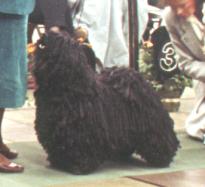 Canadian and American Champion Csanyteleki Cigany at three and a half years of age. The shape of the coat at about 3 years, before it all hits the ground, is a good guide. At that point itís past the gawkies, but still has a natural, layered, growing in pattern. If you have a photo taken at this age, use it as a guide. If there is a lot of damage, like at the shoulders, chest, and elbows, from scratching, donít leave the odd precious long cord hanging. Precious as it is, as soon as you remove it, youíll realize how much better he looks without it. And try to layer the undamaged coat into the damaged area, bit by bit, as it grows out. Layer the ear coat into the head coat if there is a lot of coat loss on top of the head. I like to stand way back, with someone holding him still, or check my work out in a mirror to get a better look at what still needs tending. I try for a balanced look, front to back. That usually means that the coat on the tail will also need to be shortened, to balance the head, which weíre keeping in a round/umbrella shape. Always have help when separating cords on the ears and tail. The texture and cording form are different in these areas, and pulling too hard can split the ear margin, or pull skin away from underlying tissues on the tail. Both are very painful. This does not mean that you should neglect these areas, however. Just be very careful, donít let it get away from you; if you donít cause pain initially, youíll have less of a fight through the next 15 years. |
